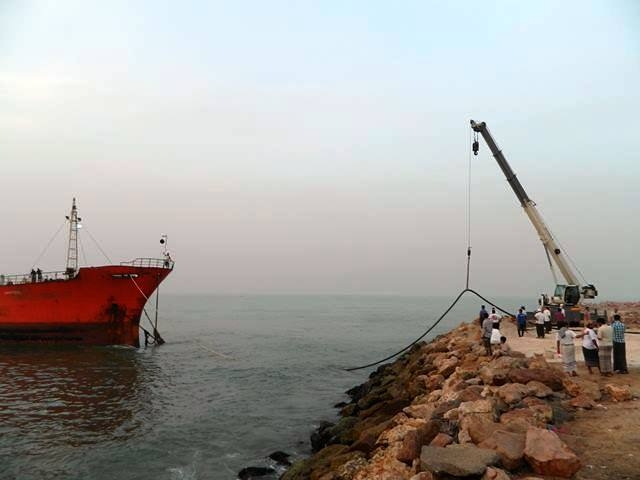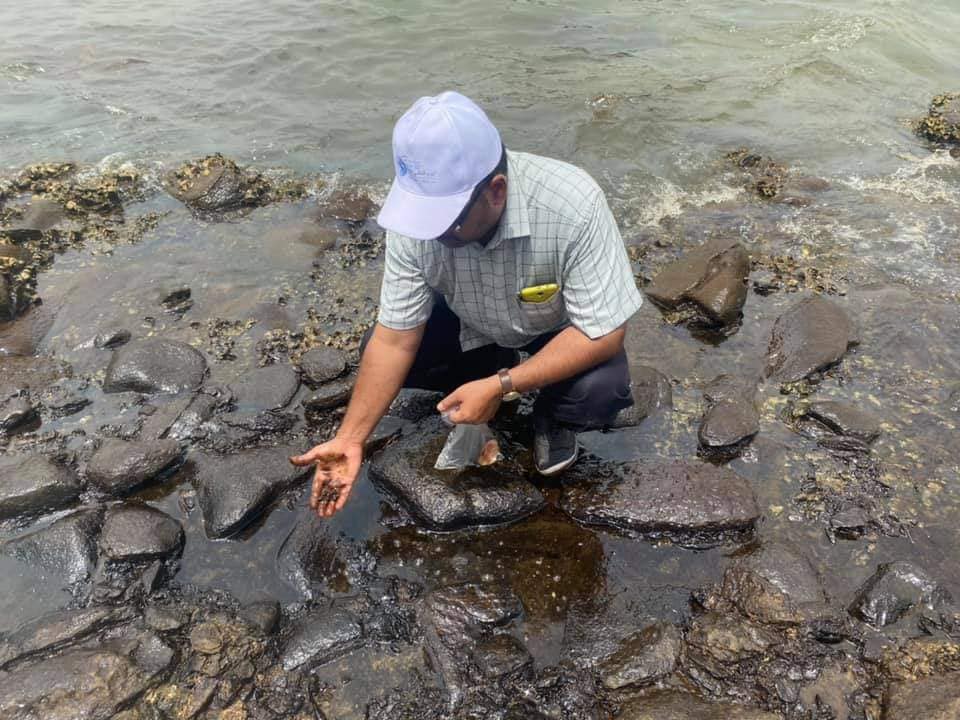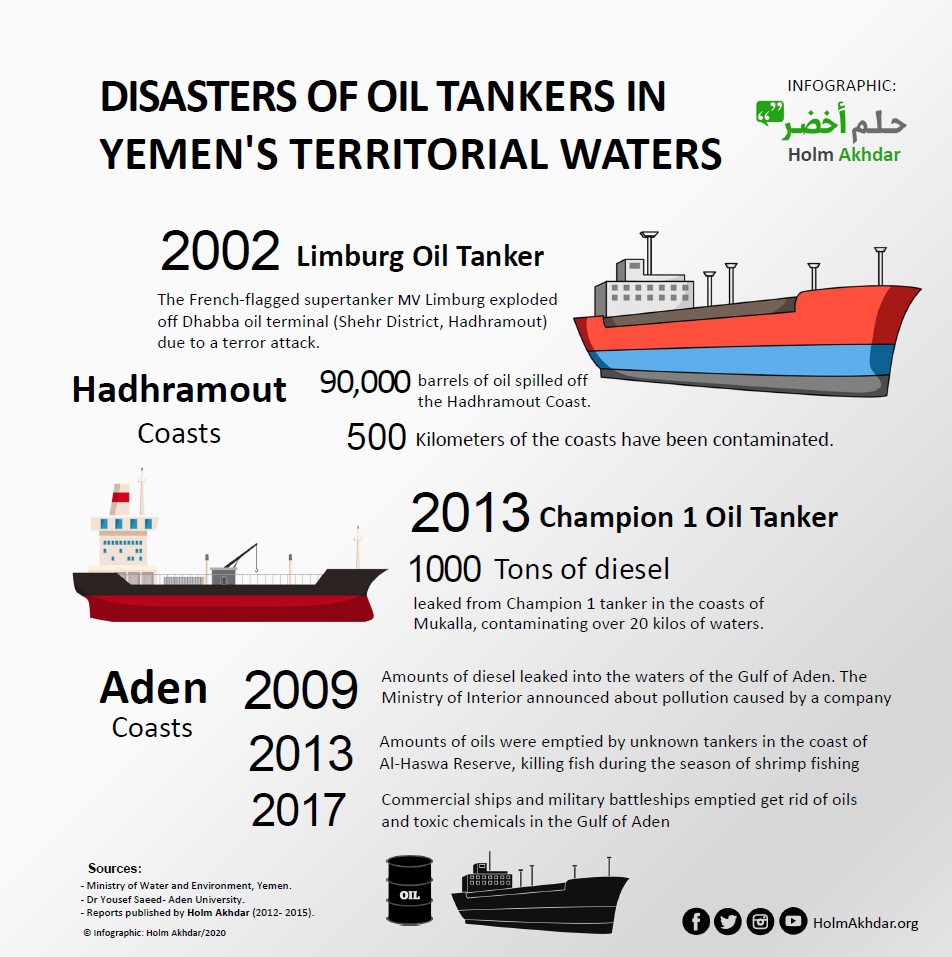by: Holm Akhdar (Sana’a)
Over the past two decades, Yemeni territorial waters in the Gulf of Aden are exposed to oil spills from ships and oil tankers, affecting marine environment and biodiversity.
This led to the pollution of large areas of beaches with oil slicks, and the death of large quantities of fish and marine life.
Moreover, the coast of the mainland is suffering from pollution and saltwater intrusion as most surface water is fully exploited upstream.
The sea along the mainland coast and the numerous Islands in the Red Sea and Gulf of Aden are within the heavily sea traffic route for every kind of ships, and prone to oil spills from ships and oil terminals.
This article tells, in a brief the story of the most prominent environmental disasters in the Yemeni coasts and waters, as a result of the leakage of oil and mazut from inside crude oil storage tanks.

Limburg Disaster
On October 6, 2002, the French-flagged Supertanker Limburg exploded of al-Dabbah oil terminal, Al-Shehr District, Hadhramout Governorate, eastern Yemen, due to a terror attack.
Nearly 90,000 barrels of oil spilled in Hadhramout Coast, in the Gulf of Aden, and 500 km of the coasts have been contaminated.
In an interview, the Former Yemeni Minister of Tourism, Abdul Malik Al-Eryani, told BBC, «That the environmental pollution resulting from the explosion of the French oil tanker had reached a very large extent.».
«That the dead fish floated off the shores of the city of Mukalla, along with the carcasses of birds.» the minister said.
According to the New York Times report, «the Limburg, leased by the Malaysian state oil company Petronas, was carrying 397,000 barrels of crude oil from the Kharg Island terminal in Iran and was preparing to take on 1.5 million more barrels of Yemeni crude at an offshore terminal near the port of Mina al-Dabah».

2009: Two Pollution Disasters
On January 19, 2009, an official report issued by the Tourism and Environment Committee of the Yemeni Shura Council (Consultative Assembly) revealed the presence of oil pollution and harmful elements affecting the marine environment in Yemen.
The official report did not mention the name of the area where the marine pollution occurred.
On September 2009, the Ministry of Interior in Yemen revealed the existence of a new marine pollution in the Gulf of Aden, accusing the involvement of a well-known businessman, during the implementation of the sea bridge project.
The Ministry of Interior indicated that the pollution resulted from the leakage of mazut into the sea. However, the name of the businessman and the company in question were not disclosed.



«Champion1» Pollutes Al-Mukalla
On July, 10, 2013, the «Champion1» tanker carrying on board 4,700 tons of mazut (diesel) caused a pollution disaster on the Al-Mukalla coast in Hadhramaut, eastern Yemen.
The «Champion1» tanker owned by government official and businessman Ahmed Saleh Al-Esai, who is close to Yemeni President Abdrabbuh Mansur Hadi.
Nearly 1,000 tons of diesel leaked from «Champion1» tanker in the coasts of Al-Mukalla, in Hadhramout, contaminating over 20 km of waters.
Yemen’s declared losses amounted to nearly $20 million as a result of the «Champion1» disaster, while the value of compensation amounted to about $6 million.
At that time, the Yemeni president commissioned one of the state companies to paying the costs of damages instead of Al-Esai Company (Overseas Co.)
Moreover, coral reefs and seagrass important to fish and other marine life are destroyed.

Pollution in Al- Heswah
As well, on September 21, 2013, local sources in the governorate of Aden reported to (Holm Akhdar) that large parts of the coast of the Al- Heswah Nature Reserve, which is the most important wetland reserve, were exposed to a pollution disaster as a result of the leakage of dangerous materials, and caused the death of shrimp and some marine life that were found Dead on parts of the coast of Al- Heswah.
It shows a video clip by “Holm Akhdar” on September 22, 2013 shows a large area of the coast of the “Al-Haswa” Aden, being polluted by oil slicks.
Spill Again from «Champion1»
On june,11, 2014, local residents in Hadhramaut governorate reported that quantities of diesel fuel spilled again from the Champion 1 ship on the coast of Al-Mukalla.
Despite the disaster, the state authorities did not take any measures or even inspect the location of the leak and did not make any attempt to suck mazut from the sea.
The Overseas Company (OSSCO), which is affiliated with the Al-Esai Trading Group, owns 20 ships and tankers to transport petroleum products between Yemeni ports.


2017: pollution in Aden
On 2017, local press reports monitored that a number of merchant ships and military battleships had emptied quantities of oils and toxic chemicals into the waters of the Gulf of Aden.
According to the environmental expert, Dr. Youssef Saeed, «this pollution witnessed on the coasts of Aden comes from two sources: the first is a marine source resulting from the unloading of commercial ships and military ships for oil and grease, and their disposal of toxic and dangerous chemicals into the sea. «
«In addition to the incidents of oil spills from oil tankers in light of the absence of oversight by the government authorities in Yemen.» Dr. Youssef explained.

«DIA» Disaster in Aden
On July 18, 2021, the government announced an environmental pollution that spread to a nature reserve as a result of the sinking of the “DIA” tanker in the dumping area in the port of Aden.
The «DIA» tanker is owned by government official Ahmed Al-Esai, the chairman of Overseas Company (OSSCO).
The incident has also rekindled concerns about the fate of the 45-year-old fuel vessel FSO Safer.
However, the FSO Safer oil tanker, abandoned 8 km off Ras Isa Port, north of Al-Hodeidah, 7 years ago, could cause a tremendous pollution disaster in case of 1,148 million barrels of crude oil onboard spilled out.
The accident figures show that oil companies are still far from meeting their overall environmental responsibilities. Even if there are substantial financial compensation, they are not enough to restore environmental balance and repair the long-term effects on environmental wealth in Yemen.

Yemen: What Needed?
According to Yemen’s National Biodiversity Strategy, the coast line of Yemen is characterized by a variety of habitats which supports a closely inter-linked and forms a unified system of major ecological and economic importance.
Today, Yemen needs major efforts for oil pollution or pollution that occurs in coastal and marine habitats.
In addition to establishing an institution responsible for treating species and rehabilitating habitats, and a decade or more ago, a special institution was established to prevent and combat oil pollution in Yemeni waters, but it is no longer present.
Yemen needs a national action plan to prevent marine pollution from land-based activities.

